BY: JOHN (JACK) W. GLASER, STD
Dr. Glaser is senior vice president, theology and ethics,St. Joseph Health System, Orange, Calif.
Ethical wisdom is the gift not of ethical experts, but rather, as I have argued in a previous Health Progress article, the gift of the right community — the "community of concern." Different ethical issues require different communities of concern, I noted. "Gathering the community of concern requires people who command essential perspectives on the issue at stake and also share an overarching concern for the common good."1
However, in generating ethical wisdom, "communities of concern" consistently need further tools. This article suggests some tools for the moral/ethical challenge of health care reform. I will:
- Develop a sketch of a macro paradigm for the ethical/moral analysis of health care plans or programs
- Explain the first stage and foundation of this process, using the experience of St. Joseph Health System (SJHS), Orange, Calif.
- Indicate some limited uses and point to further work needed in order to build on this foundation
Macro Ethical Paradigm
 The pyramid figure is the macro paradigm that guides the ethical process described in the following pages. The arrow in this illustration indicates that, like the noted psychologist Abraham Maslow's "Hierarchy of Needs," the analysis of health care programs requires an inner organic structure and sequencing. This structure and sequencing is analogous to the law of human development — one cannot skip infancy and childhood and get right to adolescence. The arrow reminds us that an adequate ethical process must be as concerned with the sequencing of analysis as it is with its substance.
The pyramid figure is the macro paradigm that guides the ethical process described in the following pages. The arrow in this illustration indicates that, like the noted psychologist Abraham Maslow's "Hierarchy of Needs," the analysis of health care programs requires an inner organic structure and sequencing. This structure and sequencing is analogous to the law of human development — one cannot skip infancy and childhood and get right to adolescence. The arrow reminds us that an adequate ethical process must be as concerned with the sequencing of analysis as it is with its substance.
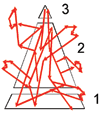 This point of starting at the foundation and moving upwards demands repeated emphasis. Most reform discussions, in my experience, start at the top, not the bottom. They fit the illustration below — starting with a specific reform proposal, the subsequent conversation plunges into a zigzag exchange, rambling from one dimension to another without direction or discipline.
This point of starting at the foundation and moving upwards demands repeated emphasis. Most reform discussions, in my experience, start at the top, not the bottom. They fit the illustration below — starting with a specific reform proposal, the subsequent conversation plunges into a zigzag exchange, rambling from one dimension to another without direction or discipline.
Three major dimensions of the guiding ethical paradigm:
- Dimension 1 — An articulated vision and priorities of health care:
Dimension 1 is the foundation on which all else must be constructed, the source from which everything else will flow, the compass that will guide the rest of the journey. Alice in Wonderland got it right: If you don't know where you are going, any road will get you there. On this foundational level, we establish that health care is a basic human good essential for the flourishing of individuals and society. We make explicit and specific the purpose, the essential elements, the priorities and limits of health care.
- Dimension 2 — Systemic/structural implications of Dimension 1:
This is the toughest, most extensive, and complex part of the ethical process. (When I began developing this ethical paradigm, I vastly underestimated both the dimension's importance and its difficulty.) Here we clarify and specify the social infrastructure required to create the vision of health care elaborated in Dimension 1 and sustain it in the future.
Americans have inherited a healthcare infrastructure — involving job-based insurance, Medicare; Medicaid; State Children's Health Insurance Program (SCHIP); Veterans Affairs; a mix of social and commercial insurance; and hundreds of other elements — that is, in large part, hostile to the vision outlined in Dimension 1. The elements of the current system were assembled in a process I would describe as "crisis-managed program-cobbling." Unlike other developed countries, the United States did not build its health care policies and practices (Dimension 3 — next column) on an analysis of necessary infrastructure (Dimension 2), resting in turn on an articulated and shared vision of health care (Dimension 1).
Americans must now use Dimension 2 to begin criticizing our current, dysfunctional infrastructure in order to create an appropriate infrastructure to replace it. Because systems of infrastructure are often obscure, analyzing them can be exacting and difficult work. It is analogous to learning a foreign language as a mature adult.
Dimension 2 does not itself involve the development of a concrete new health policy and program. Rather, it deals with intermediate issues between the vision (Dimension 1) and specific policy proposals and programs (Dimension 3). Insurance is an example of the kinds of issues that must be determined in Dimension 2. Two types of insurance exist today: social and commercial. Social insurance exists when the community,acting as a community, pools its resources and manages them for the common good. Police protection, elementary education systems, national defense and Medicare — all social mechanisms protecting some aspect of the common good — are examples of social insurance.
Commercial insurance, on the other hand, exists when a for-profit business manages limited risk with actuarial expertise in order to generate profits. Life insurance and auto insurance are examples of commercial insurance.
Because both social and commercial programs are called "insurance," and because both are so thoroughly embedded in contemporary U.S. health care, it is easy to overlook the enormous differences between them — especially their different capabilities as social infrastructure to create and sustain the vision of health care developed in Dimension 1. This is why Dimension 2 is so important — it helps one note and critically examines the differences.
Dimension 2 involves:
- Becoming clear about such key distinctions
- Gathering data relevant to judging the relative importance of those distinctions
- Determining whether, and to what extent, one or the other of these mechanisms — social insurance or commercial insurance — is more compatible with creating and sustaining the vision and priorities established in Dimension 1.
Dimension 2 engages the community in a series of such critical, clarifying explorations of the structural implications of Dimension 1.
- Dimension 3: Policy and program for U.S. health care
Now that we have elaborated our vision and its priorities (Dimension 1) and specified the nature and extent of the social infrastructure that will be required to create and sustain such a purpose and vision (Dimension 2), we are finally in a position to make ethical judgments about specific health care plans or programs.
Three different but related activities can be performed at this level. In Dimension 3, one can:
- Ethically evaluate and compare various health care proposals (at the state and federal levels)
- Ethically evaluate and compare long-standing programs (Medicare, Medicaid, job-based insurance) that, until now, have been accepted with little or no ethical analysis
- Create alternative policy proposals and work for their adoption, guided by the conclusions drawn from Dimensions 1 and 2
Dimension 3, the pyramid's peak,is the end point of the ethical process, not its beginning. Unfortunately, this organic sequencing has been recognized neither in the historical development of U.S. health care nor in most reform discussions. Americans repeatedly begin where we should end. Leaders in the political, academic, church, health care and ministry realms tend to begin the discussion where it should end. They become fixated on plans and proposals without having done all the hard,foundational work that must precede it. This ethically dysfunctional behavior is a root cause of the failure of so much reform activity, both secular and Catholic. We are addicted to foundation-less solutions.
However, the ethical paradigm discussed here enables the community to move through the layers and sequencing of analysis needed to match the ethical complexity of health care reform.
Developing Dimension 1 at SJHS
Returning now to the base of the ethical pyramid, I will describe how SJHS is attempting to move through the ethical process in a methodical way. The good news is that, by making progress on Dimension 1, one can produce a valuable degree of moral clarity and consensus, as well as some practical tools for social action. The bad news is the moral clarity is not as sharp as will eventually be needed for either a robust evaluation of proposals or the construction of an ideal program.
Our local ministry leadership consists of eight local boards of directors and eight teams of senior executives. These 16 groups engaged in two rounds of meetings about Dimension 1. In 2005, each of these groups had the pyramid explained, took the survey, and spent about an hour discussing their survey outcome, its meaning, and its place in the pyramid.
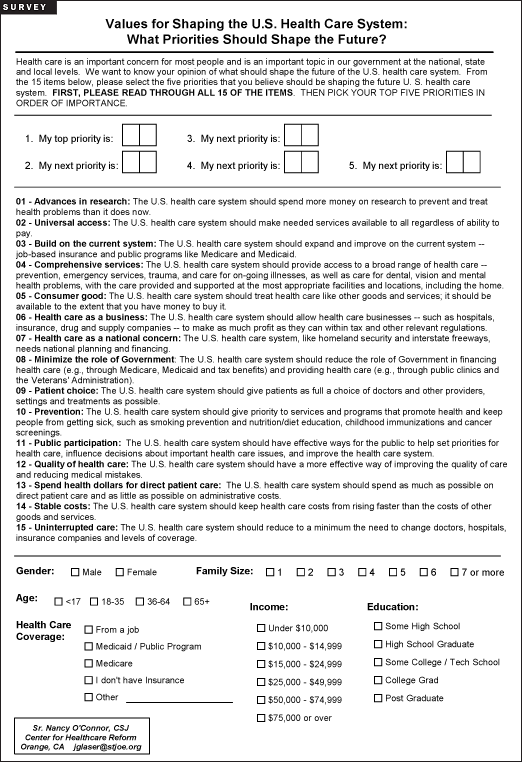
The content of these meetings was used to draft a vision statement. In a second round of meetings in 2006, this draft vision statement was discussed and revised by each of these 16 groups and forwarded to the SJHS System Board for its discussion and approval. It was approved as a working document in January 2007.
Turning the Vision into Tools
The vision statement provides a conceptual platform from which we can build further structures and processes in two directions, vertically and horizontally. Vertical construction would move into Dimensions 2 and 3 of the process. Now, I will focus on further horizontal construction — developing tools of discernment at the foundational level.
The Linear Grid for Ethical Discernment
Using the vision, we can create a linear grid that structures reflection and judgment on each of the Vision's eleven elements. The grid asks us to assign a numerical score (ranging from +3 to -3) about how well or poorly a proposal promotes the 11 priorities; it also asks for a rationale.
The discernment tool can be adapted to fit different groups' needs.
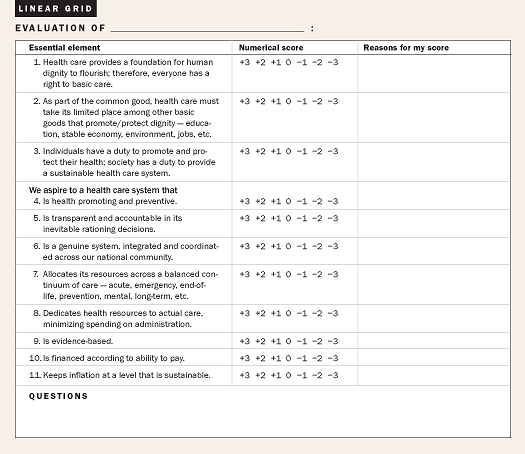
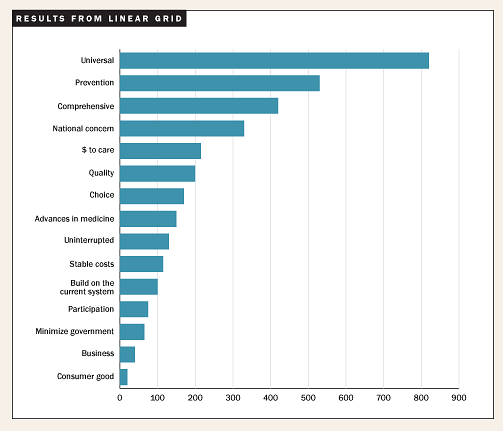
The Spider Graph
The linear assessment tool can be translated into a spider graph, thereby allowing us to plot a single program and visually represent a nuanced, multidimensional ethical assessment. It provides further ethical leverage when it is used to plot multiple programs and their strengths and weaknesses relative to one another, as in the example.

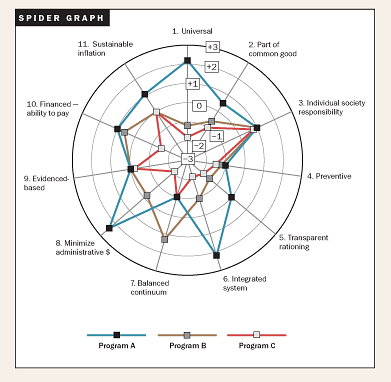
The Tools' Limits and Possibilities
The linear grid and the spider graph possess both limits and possibilities.
Limits
Because we are working now in Dimension 1, at the bottom of the ethical pyramid, we should not be surprised to discover that our tools are basic and limited. We will have a much more robust set of ethical tools when we have worked our way through the many layers of Dimension 2.
These basic tools, presented here,will seldom give a clear indication as to whether one should vote for or against specific health care legislation. If, in a political campaign, each of six candidates should propose a health plan, these tools will not tell us which to accept and which to reject, or even how to rank them according to their value. There are two main reasons for this: For one thing, campaign proposals are ad hoc compromises, based on expediency and feasibility. And then, too, our ethical tools are as yet at an unfinished stage.
Possibilities
Two obvious, immediate possibilities are opened to us with these tools. First, they can help us have disciplined and systematic ethical conversations — conversations that are both extremely important and, unfortunately, rare.
For example, although I have been doing health care ethics in Catholic institutions for 30 years, I have never experienced a conversation among ministry leaders about the significant ethical differences among Medicare, Medicaid and job-based insurance. Ethicists have also been mute on this topic. I've heard no such discussion despite the fact that, measured by Catholic principles, there are moral differences among these programs. A key factor in this long and puzzling silence is our ministry's lack of readily available tools of ethical discourse and discernment. But even the rudimentary tools provided by Dimension 1 can help us in our discernment,discussion, and advocacy.
The second possibility offered by the tools is this: They can enable us to make basic and rough ethical analyses and comparative judgments among the many health care proposals currently emerging at the state and federal levels. As primitive as they are, the linear grid and the spider graph allow us, as individuals and groups, to plot multi-level judgments about the various proposals' comparative moral strengths and weaknesses. As a result, even if we choose to support a substantially flawed, short-term solution (for example, SCHIP), the tools can make us more aware of both the specific nature of the compromises involved and the longer-term destination to which justice ultimately calls us.
Three Practical Steps; Three Time frames
Now consider three "next steps" that might flow from the argument above. Each step has a different time frame.
1. Practice Systemic Ethical Examination
One can begin to practice systemic ethical analysis of specific programs and proposals. Start with a comparison of Medicare, Medicaid, and job-based insurance. Assume, for the sake of moral dialogue, the SJHS vision statement is a "good enough" articulation of what Catholic social morality would define as a just health care system.
Using the linear grid and the spider graph, compare Medicare, Medicaid and job-based insurance. One could first do this as an individual. Then, as participants in a group, they could listen to one another's judgments and rationales. As a group, they could develop a consensual graph — one that all participants can live with. Finally,they could take time to formulate the insights, drawn from this exercise, which can be applied to the longer-term process of health care reform.
2. Develop a Ministry "Vision of U.S. Health Care"
Next, I suggest readers develop a "Vision of U.S. Health Care" that can be affirmed by Catholic health ministry across the country. Although the vision will not be cast in Catholic language, it will flow from our spiritual heritage. I have elsewhere criticized our continued use of the "cover the uninsured" slogan, characterizing it as "a flawed moral frame."2 Our ministry needs a crisp but substantial substitute for this misleading moral frame, one that can guide further necessary work. A one-page vision could serve that purpose.
3. Help the U.S. Public Formulate Its Vision
Finally, the Catholic health ministry needs to help the American public formulate its vision of health care. A lasting, systemic reform movement can be built only on a consensual vision of the general public. More than that is needed, of course — but without that foundation, nothing solid and lasting can be built.
Dr. Glaser requests reader feedback about both the article's substance and any use (including inevitable improvements) of the ideas and tools mentioned in it. For comments, inquiries or e-copies of the tools mentioned here, e-mail him at [email protected].
NOTES
- Glaser, J., "The Community of Concern," Health Progress, March-April 2002, pp. 17-20.
- Glaser, J. "'Covering the Uninsured' Is a Flawed Moral Frame," Health Progress, March-April 2006, pp. 4-9.
St. Joseph Health System Vision of Health Care
- Because health care provides a foundation for human dignity to flourish, everyone has a right to basic health care.
- As part of the common good, health care must take its limited place among other basic goods that promote/protect dignity — education, stable economy, environment, jobs, etc.
- Individuals have a duty to promote and protect their health; society has a duty to provide a sustainable health care system.
- We aspire to a health care system that:
- Is health promoting and preventive.
- Is transparent and accountable in its inevitable rationing decisions.
- Is a genuine system, integrated and coordinated across our national community.
- Allocates its resources across a balanced continuum of care — prevention, acute, emergency, end-of-life, mental, long-term, etc.
- Dedicates health resources to actual care, minimizing spending on administration.
- Is evidence based.
- Is financed according to ability to pay.
- Keeps inflation at a level that is sustainable.
- We commit ourselves, with our communities, to make this vision of human dignity a reality.
Copyright © 2008 by the Catholic Health Association of the United States.
For reprint permission, contact Betty Crosby or call (314) 253-3477.